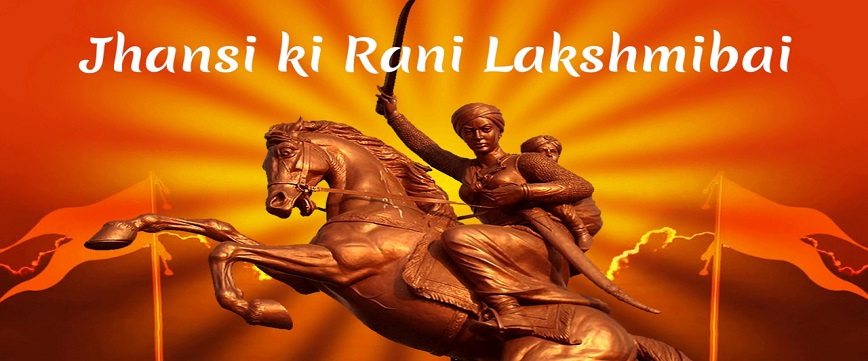
Jhansi ki Rani: Early Life
In 1828, Manikarnika Tambe was born in Varanasi to Moropant Tambe and Bhagirathi Sapre (Bhagirathi Bai). She went by the name Manu. When she was four years old, her mother died. A court Peshwa of Bithoor named her "Chhabili," which means playful. Eventually, her father made her his heir.
In contrast to most girls of her era, Lakshmibai had an unconventional upbringing. She obtained her early education from home and later became skilled in martial arts, sword fighting, horseback riding, shooting with a rifle, and fencing. She was raised alongside Nana Sahib and Tantia Tope as they learned mallakhamba under the tutelage of the Persian ambassador to India.
Jhansi ki Rani and Annexation of Jhansi
The woman who married the Maharaja of Jhansi and became known as Lakshmi Bai was born Manikarnika Devi. She married Gangadhar Rao Newalkar in 1842, and Laxmibai became popularly known by her name after the goddess Lakshmi. Her son Damodar Rao died four months after his birth, but he was adopted by the Maharaja. That same day before he passed away, Damodar Rao changed his name to Damodar Rao which was also his uncle's name. The British political officer had a letter from the Maharaja that instructed him to treat Anand like a member of the family, and the execution of adoption procedures accompanied it.
Lakshmi bai, who was popularly known as "the Rani of Jhansi" to the British public, was furious about the turn of events. She decided not to give the British control over Jhansi. In March 1854, after being given a directive to vacate the palace and fort of Jhansi and receive 40,000 rupees a month, Lakshmi bai summarily refused it.
The Revolt of 1857 & Jhansi Ki Rani
In May of 1857, a sepoy mutiny against the British East India Company broke out in Meerut, a garrison town.
Although the British governor of Central India, General Sir Hugh Rose, had not permitted Lakshmibai to assemble an armed force, she'd already begun gathering weapons within her principality. In several north Indian cities, rebellions were quickly spreading while other landlords and owners of princely estates who were unhappy started to rise in rebellion against the British army.
Check out all the facts about the life of your favorite personalities.
Find the best biographies of all time. Click here to know more about Indira Gandhi Biography, History, Facts, Airport, Death, Achievement, University & Chhatrapati Shivaji Maharaj Biography, Story, History, Airport.
Although the British had promised to send soldiers to Jhansi in March 1858, when they arrived in April, they were surprised by the level of defense the city put up. Heavy weapons that could fire across the entire town were installed in the fort. The Central Indian Field Force commander, Sir Hugh Rose, warned that the city would be destroyed if it did not submit.
Lakshmi bai was fierce and sent a plea to Tantia Tope asking for assistance in defeating her enemy. On March 23, 1858, when Rose besieged Jhansi - she engaged in combat with him and his troops until they ultimately surrendered. In addition to fighting and shooting back at her enemy (the British), she asked Tantia Tope for assistance - who gladly came through - and avoided any destruction of her sacred city of Jhansi.
Despite the British overwhelming her forces, Lakshmibai refused to give up. With Badal, Damodar Rao on her back and Khuda Bakhsh Basharat Ali (commandant), among others, by her side, she managed to escape in the night escorted by her guards. Other valiant warriors who fled with her were Dee Lala Bhau Bakshi, Moti Bai, Deewan Raghunath Singh, and many others.
On May 22, 1858, British soldiers invaded Kalpi and took control of it. Despite being outgunned and fighting on the weak ground with a small army, Lakshmibai was able to escape to Gwalior where she joined other Indian soldiers in defending the city fortress. After fighting for nearly a month, the Indian army led by Lakshmibai was successful in taking control of the city fortress after winning decisively against much larger British troops at Morar.
Death of Jhansi Ki Rani
On June 17, 1858, Lakshmibai commanded a violent engagement with a squadron of the 8th (King's Royal Irish) Hussars under Captain Heneage in Kotah-ki-Serai. Some sources claim that she died when a soldier "dispatched the young lady with his carbine," while other sources claim that the Rani, who was dressed in a cavalry leader's attire, engaged in a fierce battle and, after becoming seriously injured, asked a hermit to burn her body to prevent the British from capturing it. Several residents of the area cremated her body after she passed away. Rose claimed that Lakshmi bai's remains were buried "with much ceremony" beneath a tamarind tree at the foot of the Rock of Gwalior.
Check out all the best biographies of all time click here to find the most credible information about Atal Bihari Vajpayee Biography, Poems, Caste, College, University & Maharana Pratap Biography, Jayanti, Image, Airport, History.
For more information visit: Rani Lakshmi Bai Biography